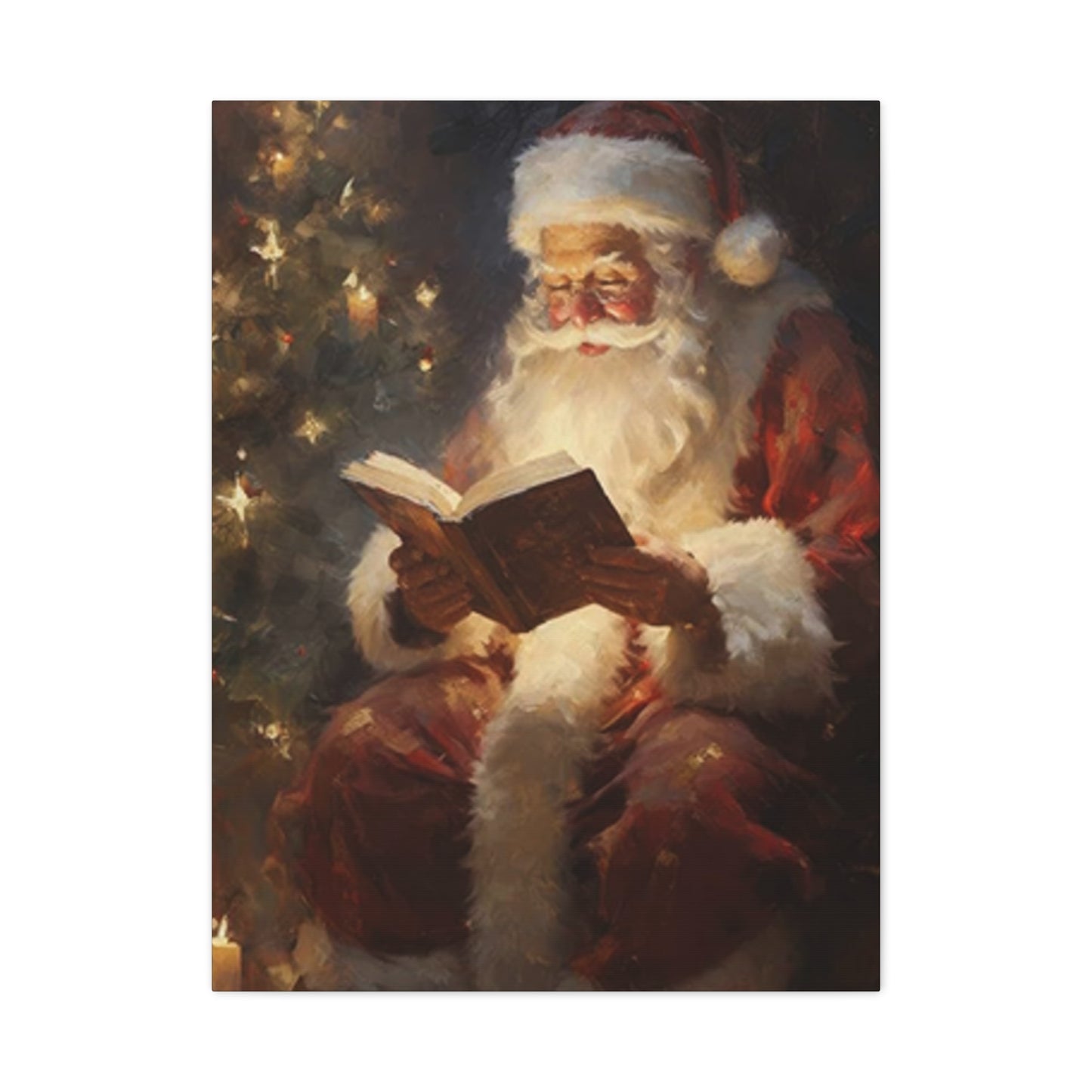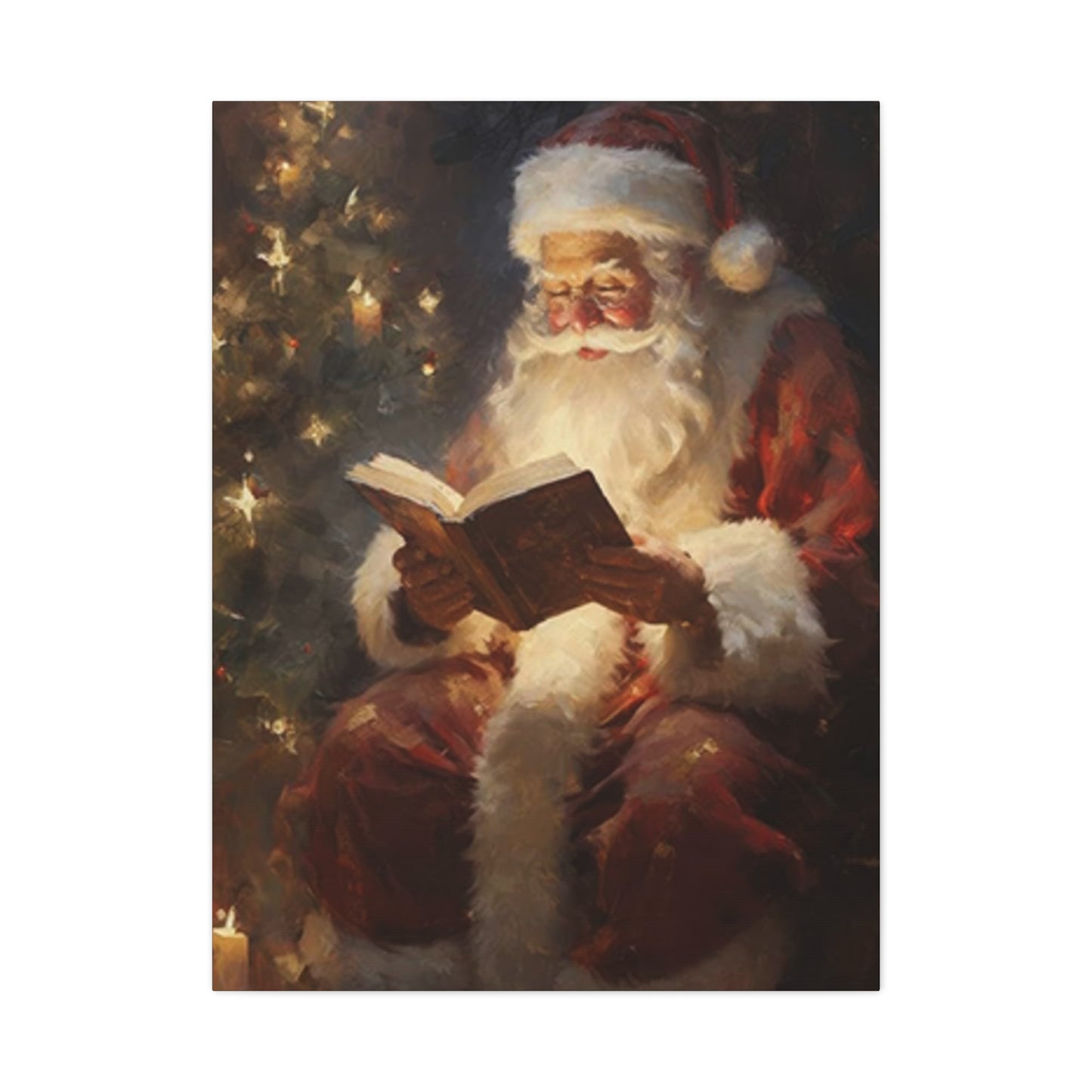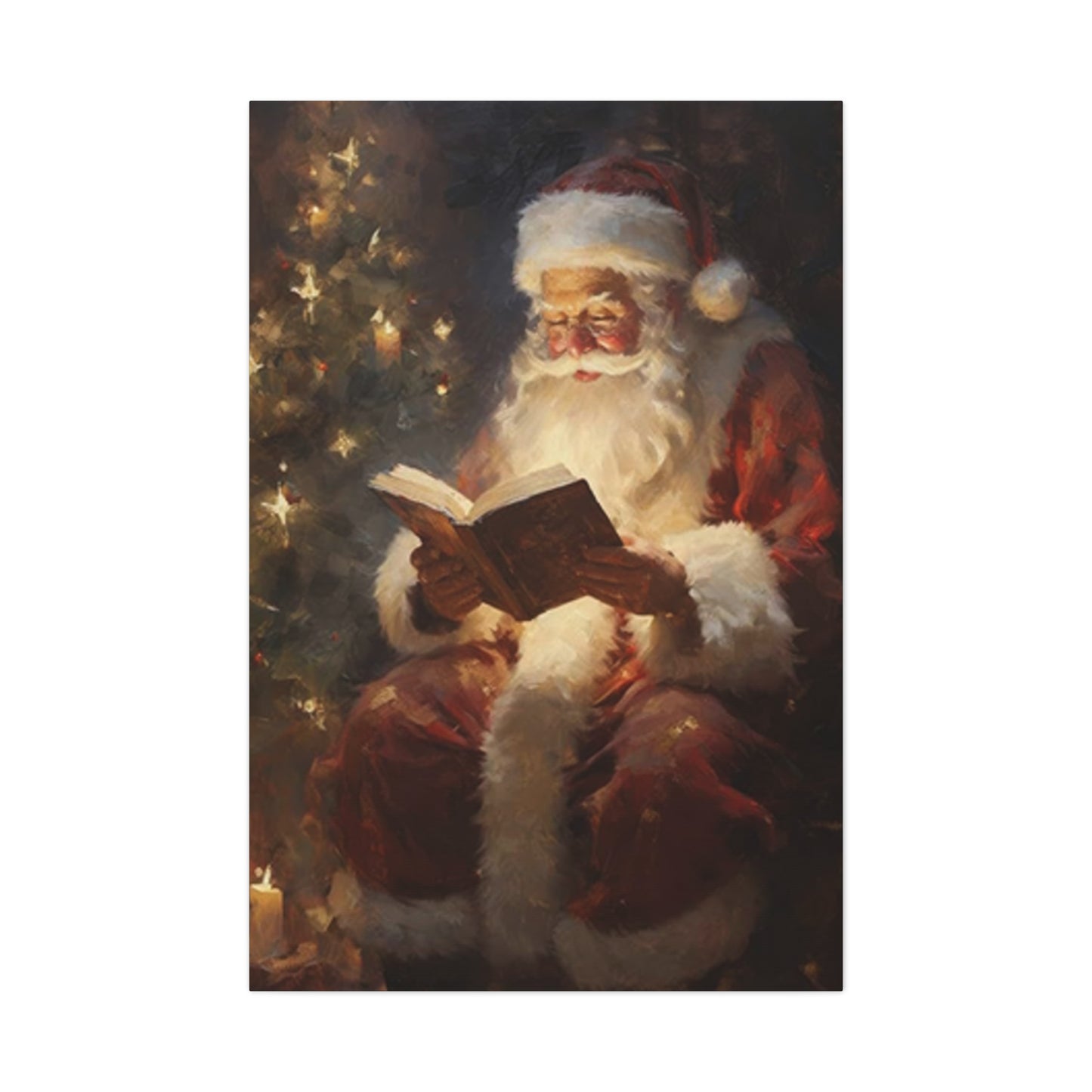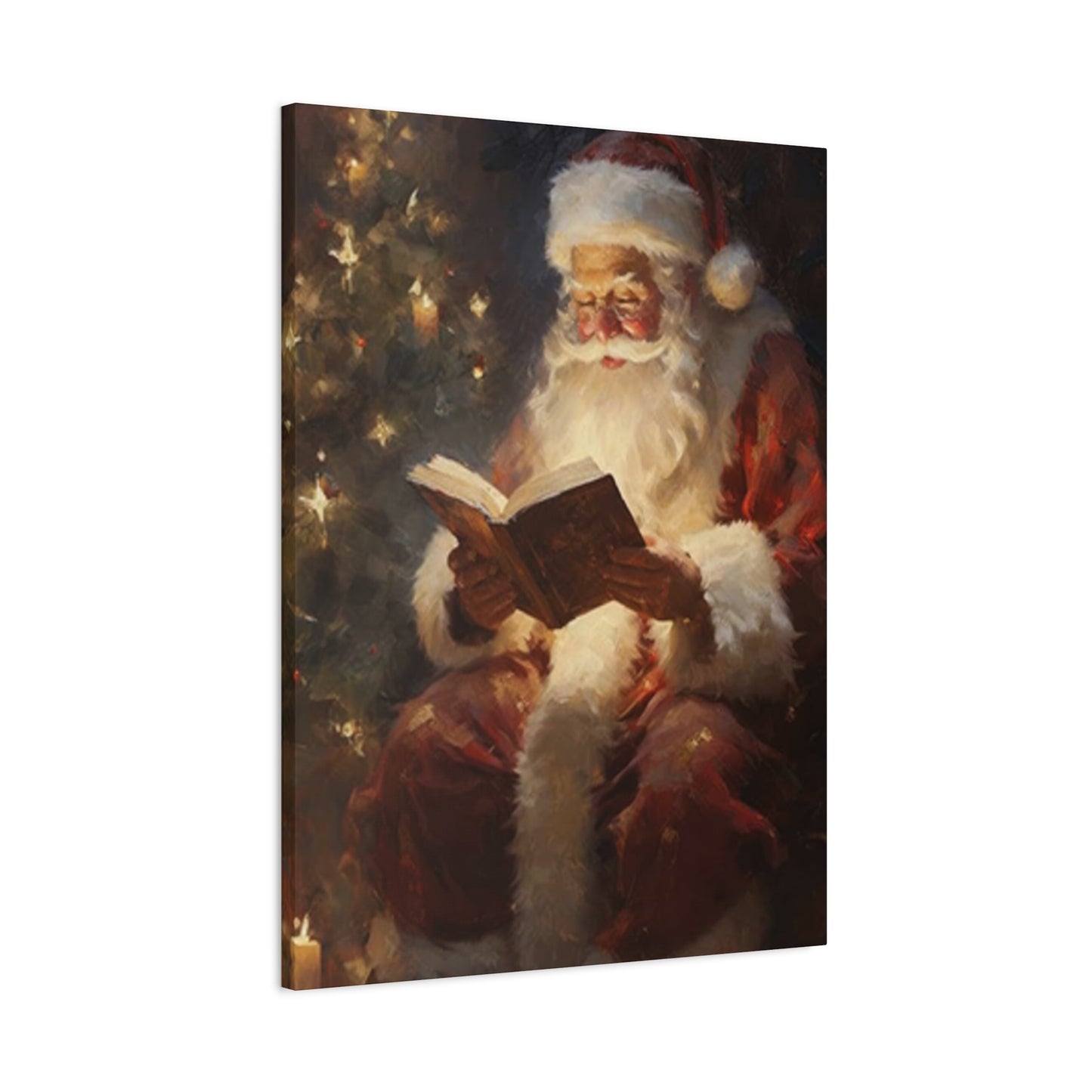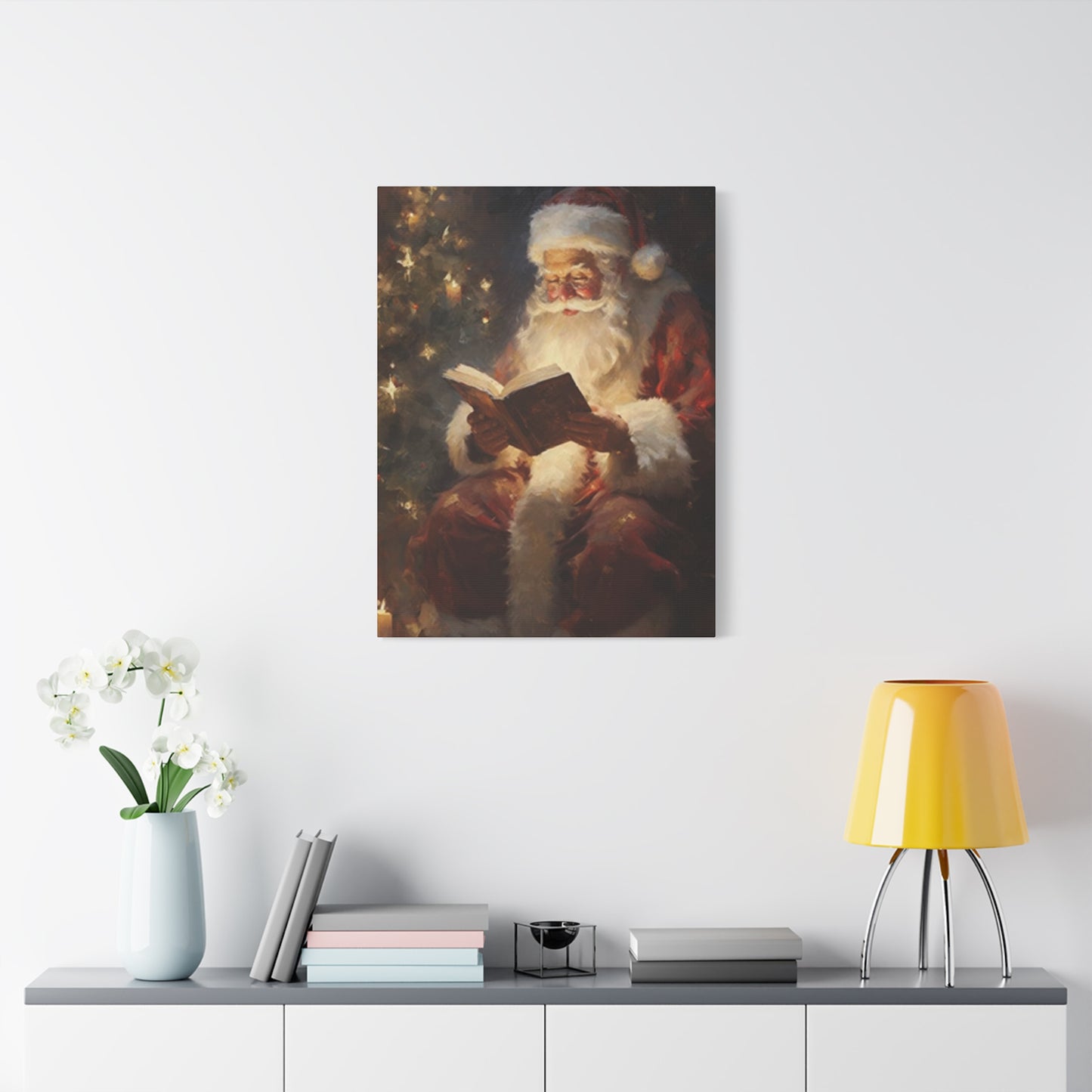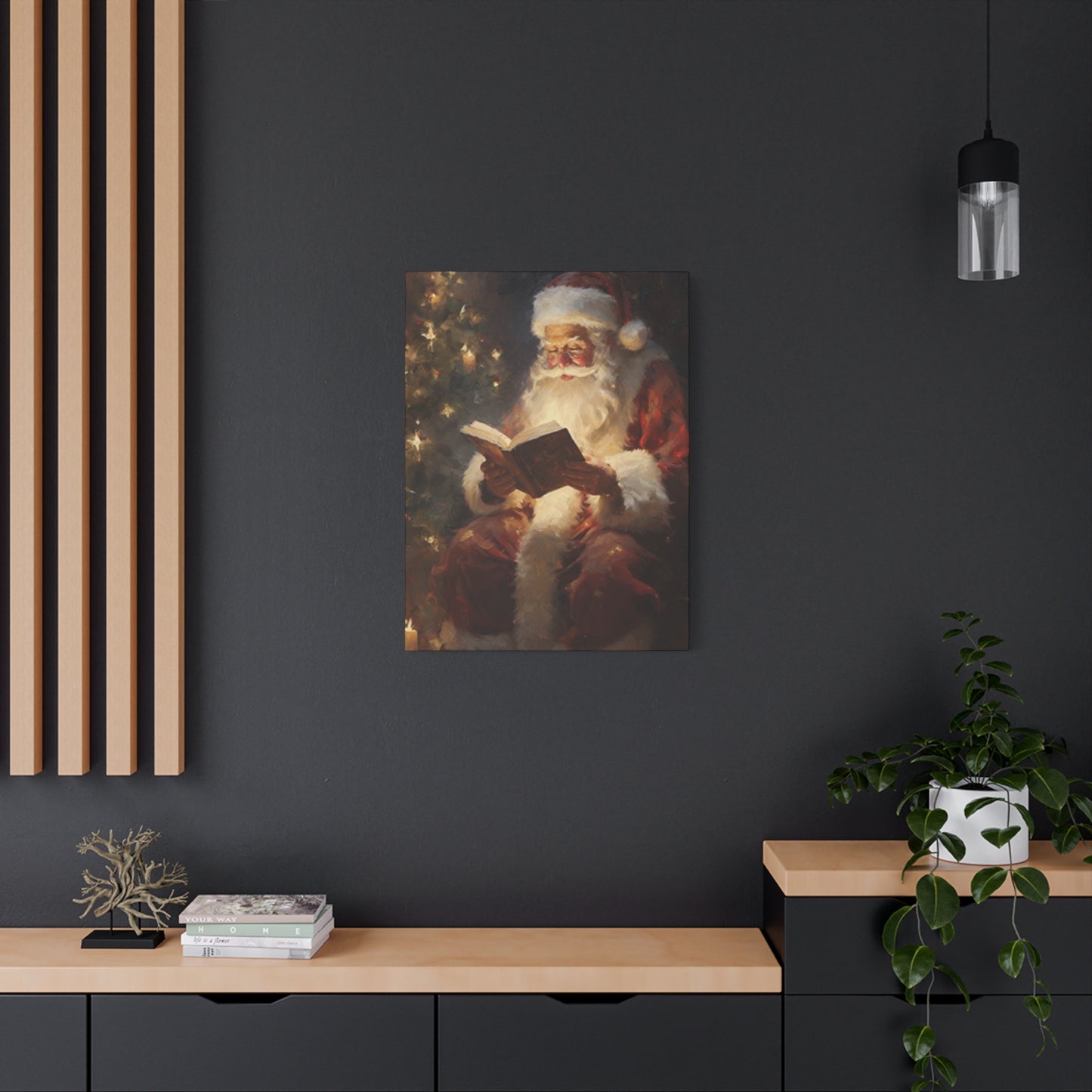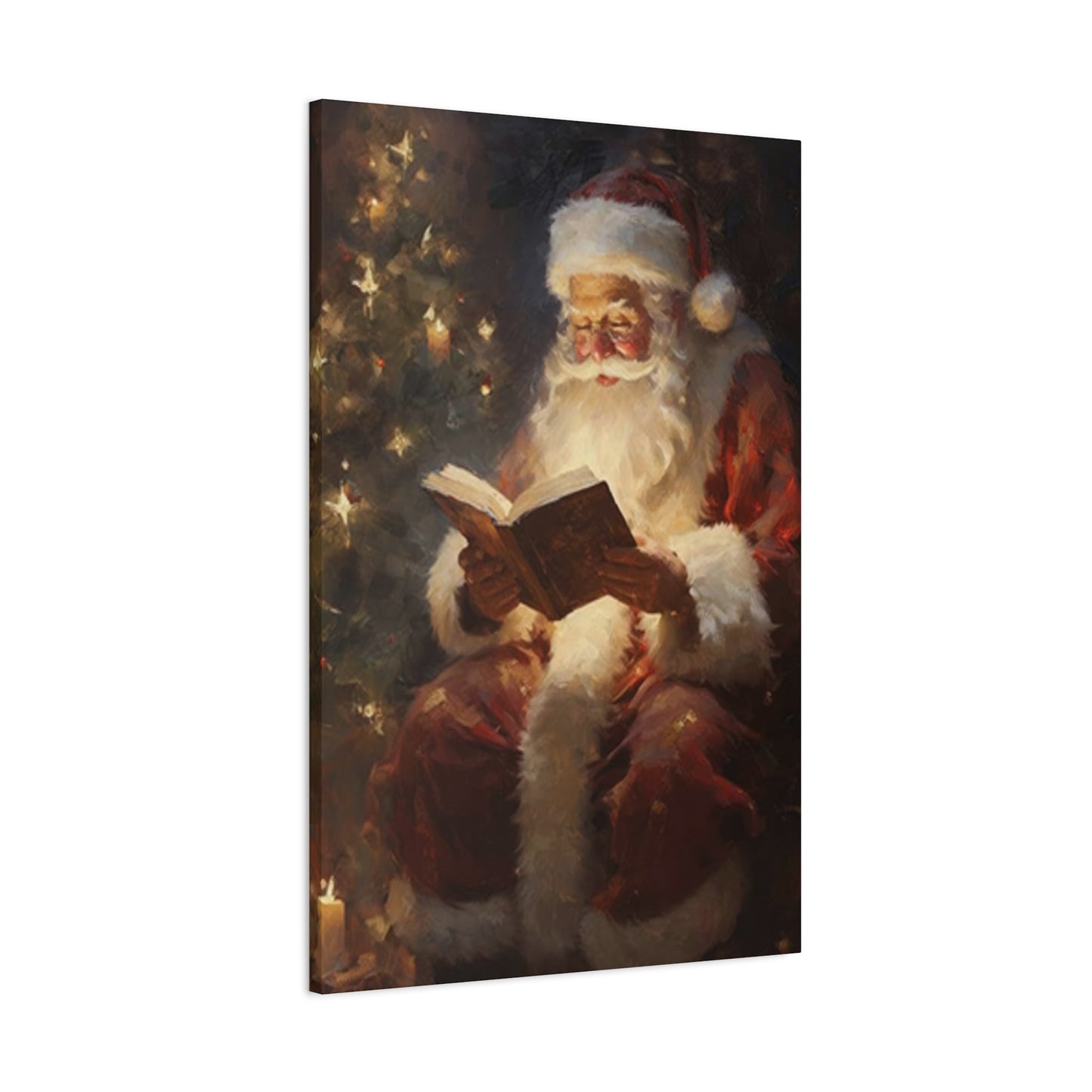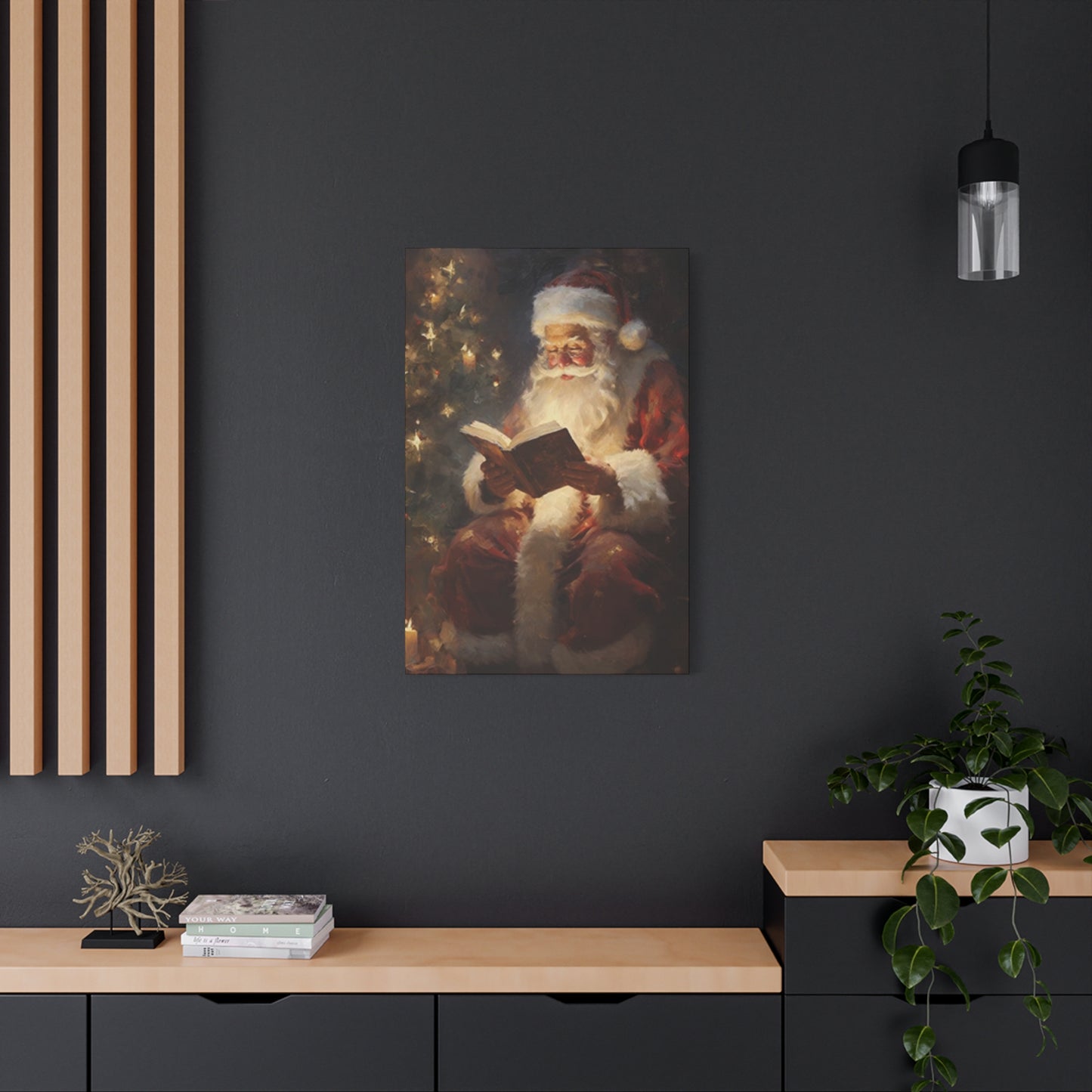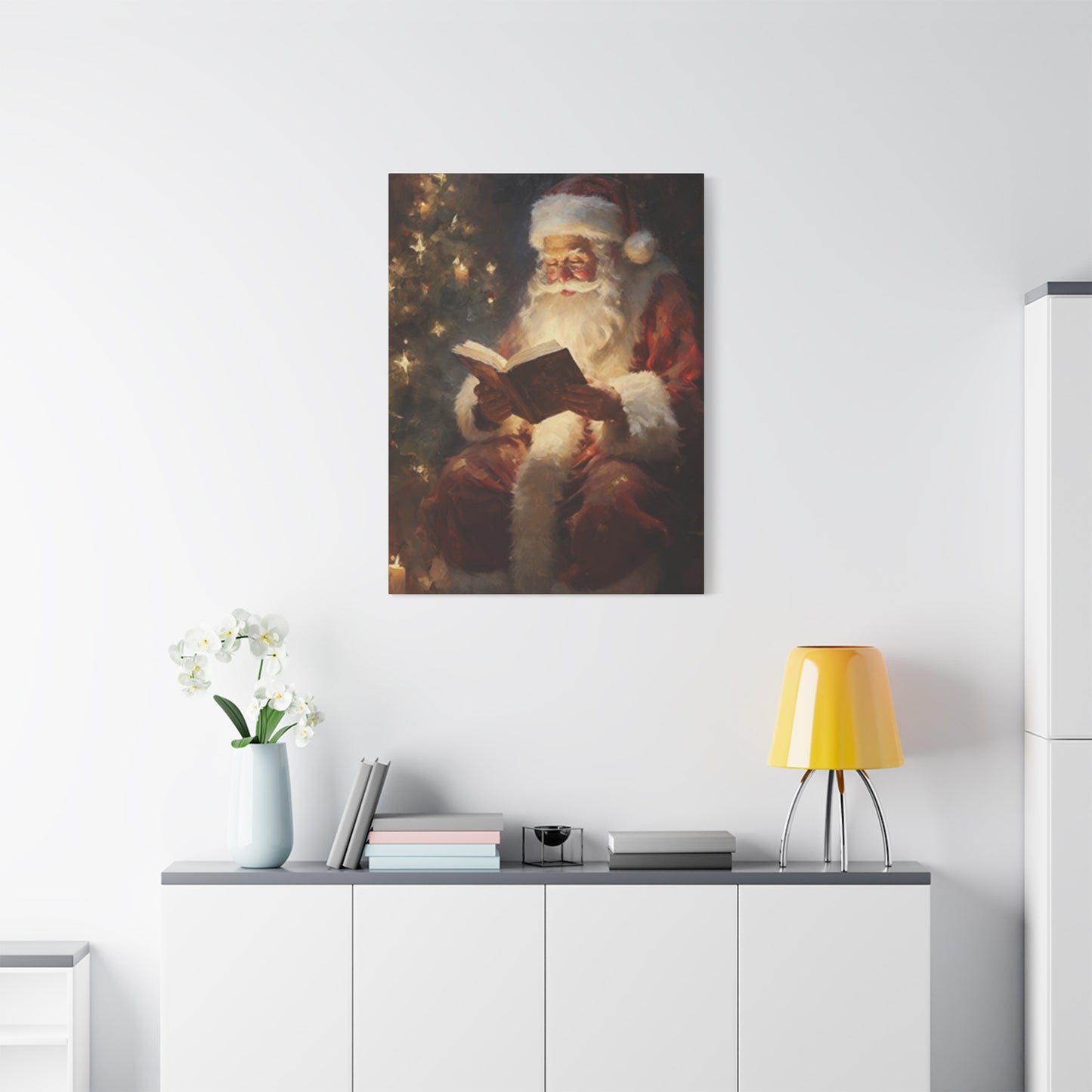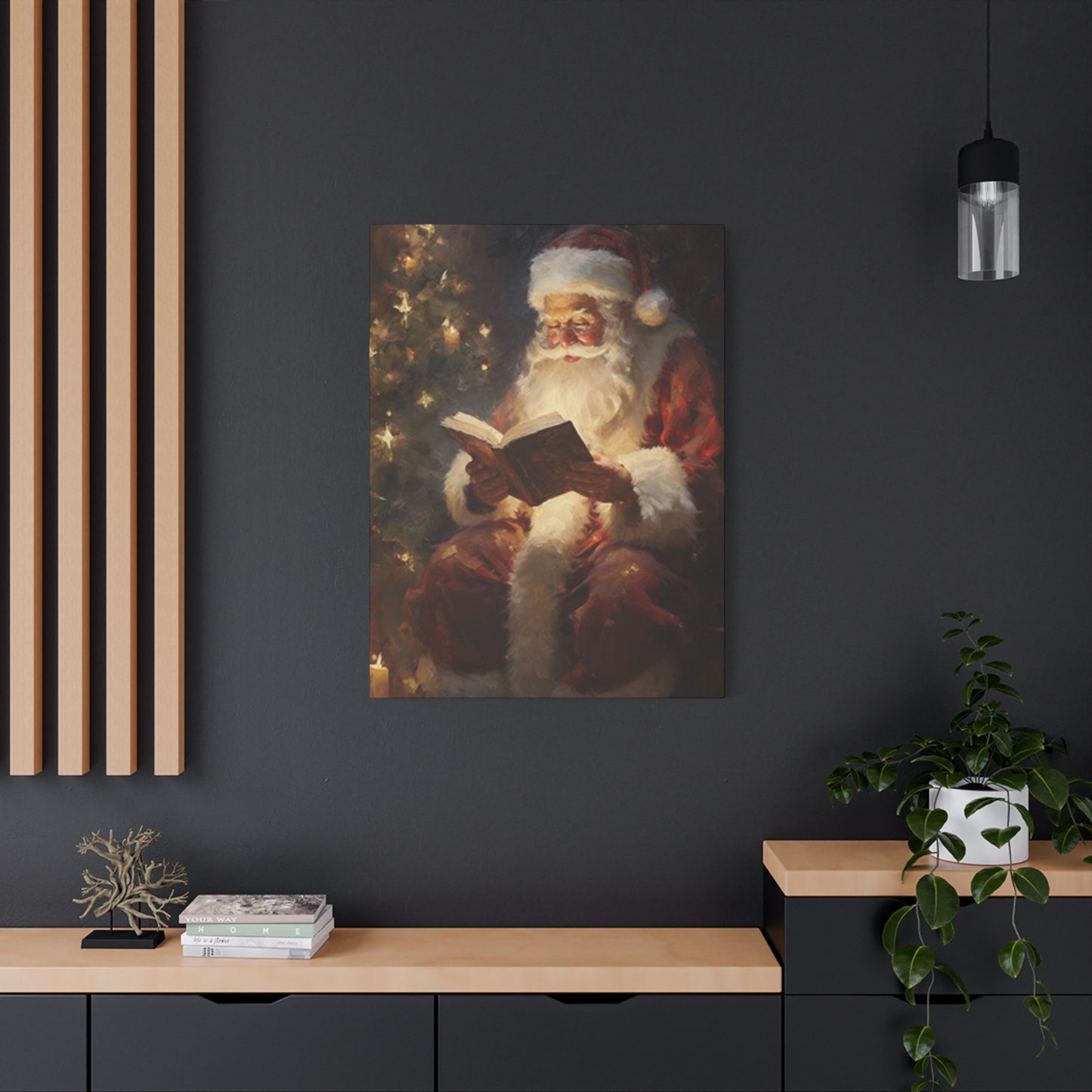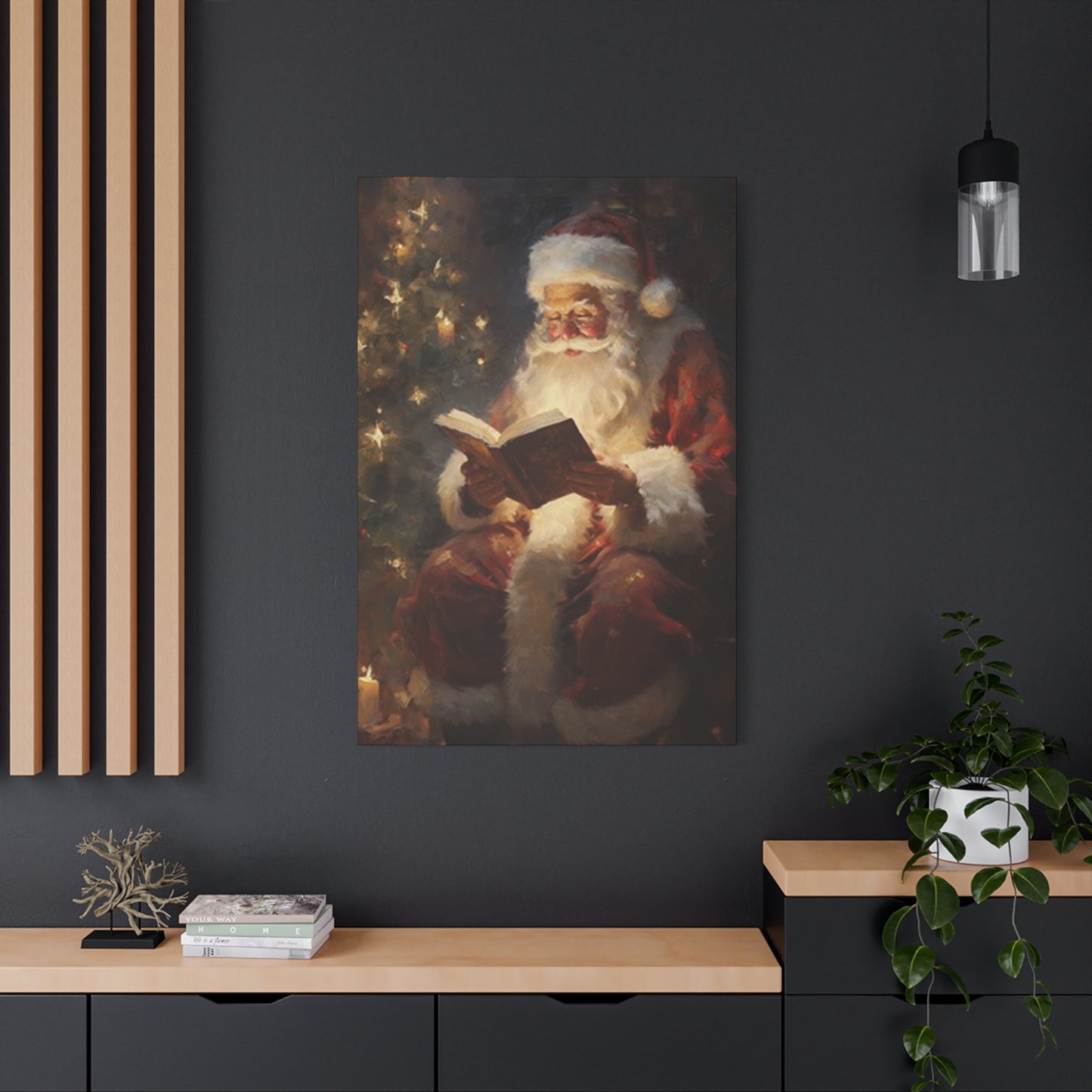Santa Claus Reading in Candlelight Painting Wall Art: A Complete Guide to Festive Home Decoration
The image of Santa Claus sitting peacefully by candlelight with a book in hand represents one of the most beloved and timeless themes in holiday decoration. This enchanting depiction captures the quieter, more contemplative side of the jolly gift-giver, offering a stark contrast to the bustling, energetic portrayals we often see during the festive season. Canvas prints featuring this serene scene have become increasingly popular among homeowners, interior designers, and holiday enthusiasts who seek to create a warm, nostalgic atmosphere in their living spaces. These artistic representations combine the magic of Christmas with the sophistication of fine art, making them versatile decorative pieces that can enhance various interior design styles throughout the winter months and beyond.
The appeal of such artwork extends far beyond simple holiday decoration. These canvas prints serve as conversation starters, focal points for seasonal displays, and cherished family heirlooms that can be passed down through generations. The intimate nature of the scene, with Santa absorbed in reading by the gentle glow of candlelight, evokes feelings of peace, wisdom, and the true spirit of the season. This imagery reminds us that Christmas is not merely about the frenzy of gift-giving and celebration, but also about reflection, storytelling, and the quiet moments of joy that make the holiday truly special.
Understanding the Artistic Appeal of Candlelit Santa Imagery
The artistic representation of Santa Claus engaged in reading by candlelight carries profound symbolic meaning that resonates with viewers on multiple levels. This particular theme draws upon centuries of artistic tradition that associates candlelight with intimacy, wisdom, and spiritual illumination. When artists depict Santa in this contemplative pose, they are tapping into a rich visual language that speaks to our collective understanding of knowledge, tradition, and the passing down of stories from one generation to the next. The warm, golden glow of candlelight creates natural shadows and highlights that add depth and dimension to the composition, making these pieces visually captivating even from a purely aesthetic standpoint.
The technical execution of such artwork requires considerable skill, as artists must master the challenging interplay of light and shadow that candlelight creates. The soft, flickering quality of candle flames produces a dynamic lighting situation that casts gentle illumination on Santa's face and the pages of his book while allowing the surrounding environment to fade into mysterious darkness. This dramatic contrast, known in art history as chiaroscuro, has been employed by master painters for centuries to create mood, direct viewer attention, and add emotional weight to their subjects. When translated to canvas prints for home decoration, this technique ensures that the artwork commands attention and creates a focal point in any room where it is displayed.
Contemporary artists working in this genre often blend traditional painting techniques with modern sensibilities, creating pieces that honor the classical representation of Santa Claus while incorporating elements that appeal to today's design-conscious consumers. Some interpretations feature Santa in his traditional red suit, complete with white fur trim and a luxurious beard, while others take creative liberties with color palettes, using muted tones, sepia effects, or even monochromatic schemes to create different moods. The choice of what Santa is reading adds another layer of meaning to these compositions. Some artists show him reviewing the famous list of good children, others depict him reading classic literature, and still others show him absorbed in ancient tomes that might contain the secrets of Christmas magic itself.
The Symbolism of Reading and Knowledge in Holiday Imagery
The specific choice to depict Santa Claus engaged in reading carries layers of symbolic meaning that enrich these artworks far beyond their surface beauty. Reading has long been associated with wisdom, learning, and the preservation of knowledge across generations. By showing Santa absorbed in a book, artists tap into these universal associations, suggesting that the beloved Christmas figure is not merely a magical being but also a keeper of stories, traditions, and perhaps ancient wisdom about the true meaning of the holiday season. This portrayal elevates Santa from a simple gift-giver to a more complex character who understands the deeper significance of his annual mission and the impact it has on children and families around the world.
The act of reading also connects Santa to the broader tradition of storytelling that forms the foundation of Christmas celebrations across cultures. The holiday season is inherently tied to narratives, whether they are religious stories about sacred births, folk tales about magical gift-bringers, or family histories shared around dinner tables. By depicting Santa as a reader, artists position him as both a participant in and guardian of this storytelling tradition. He becomes a figure who not only delivers physical gifts but also preserves and passes along the intangible gifts of stories, values, and cultural memory. This deeper interpretation resonates particularly strongly with adults who understand that the most meaningful aspects of Christmas often have little to do with material presents and everything to do with shared experiences and cherished traditions.
Furthermore, the image of Santa reading can be interpreted as representing the careful consideration he gives to his important work. Many artistic depictions show him reading what appears to be his famous list of children's names, suggesting that he approaches his gift-giving duties with thoughtfulness and attention to detail. This portrayal reassures viewers, particularly children, that Santa knows them individually and considers their unique qualities when preparing for Christmas Eve. For adult viewers, this same imagery might evoke feelings of nostalgia for their own childhood beliefs or inspire them to approach the holiday season with similar thoughtfulness and care in their own gift-giving and celebration planning.
Choosing the Right Size for Your Space
Selecting the appropriate dimensions for canvas artwork requires careful consideration of multiple factors related to your specific space and design goals. The size of the print dramatically affects its visual impact and how well it integrates with surrounding elements in your room. A piece that is too small for its designated wall space can appear insignificant and fail to command the attention it deserves, while an oversized print might overwhelm the room or make the space feel cramped and claustrophobic. Finding the right balance depends on understanding basic principles of proportion and scale while also considering the specific characteristics of your room and your personal aesthetic preferences.
As a general guideline, artwork should occupy roughly two-thirds to three-quarters of the available wall space above the furniture it hangs over. This proportion creates a visually pleasing relationship between the furniture and the artwork, making them appear as a cohesive unit rather than disconnected elements. For example, if you plan to hang your Santa Claus reading canvas above a sofa that measures seventy-two inches wide, the ideal artwork width would fall between forty-eight and fifty-four inches. This guideline works well for most traditional arrangements, though contemporary design sometimes intentionally breaks these rules for dramatic effect, using either much smaller artwork to create a minimalist statement or much larger pieces that dominate entire walls.
Room size and ceiling height also significantly influence optimal artwork dimensions. In rooms with standard eight-foot ceilings, vertical space is somewhat limited, making horizontal or square compositions often more practical than tall vertical pieces. However, rooms with higher ceilings can accommodate larger vertical works that draw the eye upward and help fill the additional wall space. The overall square footage of the room matters as well; a piece that looks perfectly proportioned in a large, open-concept living area might appear overwhelming in a smaller, more intimate space like a cozy reading nook or bedroom. Consider viewing distance as well, as artwork that will be viewed from farther away can and should be larger to maintain its impact.
The specific design and composition of the artwork itself should inform your size selection. Highly detailed pieces with intricate elements benefit from being printed at larger sizes, allowing viewers to appreciate all the artistic nuances without straining. A canvas depicting Santa Claus reading by candlelight might include fine details like the texture of his fur-trimmed suit, the individual pages of his book, or the intricate patterns of shadows cast by the flickering candle flame. These elements become more visible and impressive when the print is large enough to showcase them properly. Conversely, simpler compositions with bold shapes and limited detail can be effective at smaller sizes, making them versatile choices for various placement options throughout your home.
Practical considerations beyond pure aesthetics also factor into size selection. Larger canvases are heavier and require more substantial hanging hardware and potentially multiple wall anchors for secure mounting, particularly if they will be hung on drywall rather than directly into wall studs. Consider whether you might need professional installation for particularly large or heavy pieces. Doorways and stairwells present another practical constraint, as you must be able to physically maneuver the artwork into its intended room. Measure not just the destination space but also the path the artwork will travel through your home, ensuring it can navigate any tight corners or narrow hallways without damage.
Color Palette Considerations for Interior Design Integration
The color scheme of your chosen canvas print plays a crucial role in how well it integrates with your existing interior design and the overall atmosphere it helps create. Santa Claus reading by candlelight scenes can feature a wide range of color palettes, from traditional and vibrant to muted and atmospheric, each creating distinct emotional responses and working better with different decorating styles. Understanding color theory and how different hues interact with one another helps you select artwork that enhances your space rather than clashing with it or feeling disconnected from the surrounding environment.
Traditional representations of this subject typically feature warm color palettes dominated by reds, golds, and amber tones. Santa's iconic red suit provides a bold primary color that immediately draws attention and establishes the Christmas theme. The candlelight contributes golden and orange hues that create a cozy, inviting atmosphere reminiscent of crackling fireplaces and warm holiday gatherings. These warm colors are psychologically associated with comfort, energy, and celebration, making them natural choices for holiday artwork. If your home features a warm color scheme with earth tones, wood furniture, or brass and gold accents, traditional-palette prints will integrate seamlessly into your existing design, creating a cohesive look that feels intentional and well-planned.
However, many contemporary interpretations of Santa Claus reading scenes employ more sophisticated or unexpected color schemes that can work beautifully in different design contexts. Some artists create versions with desaturated, almost sepia-toned palettes that emphasize the vintage, nostalgic qualities of the scene. These muted interpretations work particularly well in homes decorated in farmhouse, shabby chic, or vintage-inspired styles, where softer colors and aged appearances are design virtues rather than flaws. The subdued colors allow the artwork to make a statement without overwhelming spaces decorated in predominantly neutral tones, and they maintain visual interest without the bold primary colors that might feel too vibrant for certain sophisticated interiors.
Cool-toned versions of Santa Claus reading artwork also exist, emphasizing blues, silvers, and white tones that evoke the winter season's icy beauty. These interpretations might show Santa reading in a blue-tinged twilight or surrounded by silvery moonlight filtering through frosty windows. Cool color palettes create feelings of calm, serenity, and spaciousness, making them excellent choices for rooms where you want to promote relaxation. They work particularly well in contemporary or modern interiors where cool grays, whites, and blues dominate the color scheme. A cool-toned Santa print can bridge the gap between holiday decoration and year-round design, feeling festive enough for the Christmas season while not clashing with a home's regular aesthetic.
Color psychology extends beyond the main palette to include accent colors and the overall value range of the piece. High-contrast images with deep shadows and bright highlights create drama and visual impact, making them ideal for spaces where you want the artwork to be a bold focal point. Lower-contrast pieces with subtle value transitions create a softer, more subtle presence that works well in spaces where the artwork should complement rather than dominate. Consider the lighting in your intended display space as well; natural daylight will render colors differently than artificial lighting, and the direction and intensity of light in the room at different times of day will affect how the artwork appears.
When selecting a color palette for your canvas print, bring paint chips, fabric samples, or photographs of your room to compare against potential artwork options. Many retailers display canvases under bright gallery lighting that differs significantly from typical home lighting conditions, so try to imagine how the colors will appear in your actual space. If possible, request samples or search for customer photos showing the artwork in real home settings rather than professional studio shots. This extra effort in the selection process helps ensure that your investment will look as beautiful in your home as it did when you first saw it.
Placement Strategies for Maximum Visual Impact
Where you choose to display your Santa Claus reading canvas significantly affects both its visual impact and the overall atmosphere it creates in your home. Strategic placement considers factors including wall space availability, lighting conditions, viewing angles, and the relationship between the artwork and surrounding furniture and architectural features. Thoughtful positioning transforms artwork from a mere decoration into an integral component of your interior design that enhances the space and creates the exact ambiance you desire during the holiday season and potentially throughout the year.
The most traditional placement for substantial canvas prints positions them as focal points above major furniture pieces such as sofas, beds, or console tables. This arrangement creates a natural visual anchor that draws the eye and establishes the artwork as a significant element in the room's design hierarchy. When hanging art above furniture, the bottom edge of the canvas should typically sit six to twelve inches above the furniture surface, creating a clear relationship between the two elements without leaving so much space that they appear disconnected. This height creates visual unity while ensuring that people seated on furniture below won't block the view of the artwork from other positions in the room.
Living rooms offer multiple excellent placement opportunities for holiday artwork. Above the fireplace mantel represents perhaps the most iconic location for Christmas decorations, creating a natural focal point that families gather around during the holiday season. The warmth of a fireplace conceptually echoes the candlelight theme in Santa reading artwork, creating thematic resonance that enhances the cozy atmosphere. Alternative living room placements include positions above sideboards or credenzas that display other holiday decorations, on the main wall opposite the room's entrance where it will be immediately visible upon entry, or as part of a gallery wall arrangement that combines the Santa canvas with complementary pieces.
Dining rooms and eating areas provide another natural home for festive artwork, as families often gather in these spaces for holiday meals and celebrations. A Santa Claus reading canvas above a buffet or on the main wall visible from the dining table becomes part of the celebration atmosphere, sparking conversations and contributing to the festive ambiance during holiday dinners. The quieter, contemplative nature of the reading theme works particularly well in dining spaces, as it creates a sophisticated atmosphere rather than the more energetic, chaotic feeling that some Christmas decorations can generate.
Bedroom placement offers a more personal and intimate way to enjoy your canvas print. The contemplative nature of Santa reading by candlelight makes it particularly well-suited to bedroom spaces, where the quiet, reflective mood enhances the room's primary purpose as a peaceful retreat. Position the artwork on the wall above the bed's headboard for a traditional arrangement, or place it on an adjacent wall where it will be visible from the bed, creating a comforting image to view as you fall asleep during the holiday season. Guest bedrooms benefit especially from this placement, making visitors feel welcomed with festive yet sophisticated decoration that enhances their stay without overwhelming them with excessive holiday theatrics.
Don't overlook less conventional spaces that can benefit from artwork placement. Entryways and foyers make excellent locations for welcoming holiday artwork that sets the tone for the entire home as guests arrive. Hallways and staircases, often neglected in decorating schemes, become more interesting and visually engaging with strategically placed artwork. Home offices and studies naturally align with the reading theme, as books and learning are central to these spaces already. The addition of Santa engaged in reading creates both holiday spirit and a whimsical encouragement toward productivity and scholarship.
Lighting Techniques to Enhance Candlelight Artwork
Proper lighting is essential for displaying artwork effectively and maximizing its visual impact. This consideration becomes particularly important for pieces depicting candlelight scenes, where the interplay of light and shadow constitutes a central element of the composition. The way you illuminate your Santa Claus reading canvas can dramatically affect how viewers perceive it, either enhancing the atmospheric qualities the artist intended or potentially flattening the image and diminishing its emotional resonance. Understanding basic art lighting principles helps you showcase your investment to its best advantage.
Natural daylight provides the most accurate color rendering and can beautifully illuminate artwork during daytime hours. However, natural light comes with significant challenges, including variability throughout the day and seasons, potential for glare depending on the angle of sunlight, and the damaging effects of ultraviolet radiation on artwork over extended periods. If your canvas will be displayed in a location that receives direct sunlight, consider using UV-protective glass or acrylic glazing, window treatments that can filter harsh light during peak hours, or simply positioning the artwork on a wall perpendicular to windows rather than directly opposite them where reflected light might create glare.
Artificial lighting offers more control and consistency than natural light, allowing you to maintain optimal illumination regardless of time of day or weather conditions. The most professional approach uses dedicated picture lights mounted directly on the frame or the wall above the artwork. These specialized fixtures direct focused illumination onto the canvas surface, creating even coverage while minimizing light spill onto surrounding walls. Picture lights come in various styles from traditional brass to contemporary chrome finishes, allowing you to match the fixture to your interior design aesthetic. Adjustable models let you fine-tune the angle and intensity of illumination to achieve the exact effect you desire.
Track lighting and adjustable ceiling-mounted spotlights offer flexible alternatives to picture lights, particularly in rooms with existing track systems or in contemporary spaces where visible lighting fixtures contribute to the overall design aesthetic. Position spotlights to illuminate artwork at a thirty-degree angle from vertical, which provides even coverage while minimizing glare and reflection. This angle also reduces the likelihood of casting shadows from the canvas texture or frame onto the wall behind the artwork. Use warm-toned bulbs rather than cool white options to complement the warm candlelight theme of the artwork and create a cohesive lighting atmosphere.
The color temperature of your lighting, measured in Kelvin, significantly affects how artwork appears. Bulbs in the range of 2700K to 3000K produce warm, yellowish light similar to traditional incandescent bulbs and candlelight itself, making them ideal for illuminating artwork depicting candlelit scenes. This warm lighting enhances the golden and amber tones in the painting while creating an atmospheric quality that reinforces the cozy, intimate mood of the piece. Cooler color temperatures above 4000K can make artwork appear washed out and clinically lit, undermining the emotional warmth that makes candlelight scenes so appealing.
Consider installing dimmer switches on lights illuminating your artwork, providing flexibility to adjust lighting intensity based on time of day, ambient room lighting, and desired atmosphere. During bright daylight hours, you might use brighter artificial lighting to ensure the artwork remains visible and impactful despite competing natural light. In the evening, lower lighting levels can create a more intimate atmosphere that echoes the candlelight depicted in the artwork itself, making the scene feel even more evocative and atmospheric.
Framing Options and Presentation Styles
While canvas prints are often displayed in their stretched, gallery-wrapped format without additional framing, various presentation options exist to customize the artwork's appearance and better integrate it with your specific interior design style. The framing or presentation choice you make affects not only the artwork's aesthetic impact but also its perceived value, its integration with surrounding decor, and even its longevity and protection over time. Understanding the available options helps you make choices that best serve your specific needs and preferences.
Gallery-wrapped canvases represent the most popular contemporary presentation method, where the printed image continues around the edges of the stretcher frame, eliminating the need for additional framing. This approach creates a clean, modern appearance that works particularly well in contemporary and transitional design schemes. The depth of the stretcher bars affects the overall look significantly, with standard three-quarter-inch depths providing a modest profile suitable for most applications, while thicker depths of one and a half inches or more create a more substantial, sculptural presence that allows the canvas to stand as an independent object rather than simply a flat wall decoration. Some gallery-wrapped canvases feature mirrored edge printing, where the image at the canvas edge reflects the border area of the main image, while others continue the actual image around the sides, and still others use solid colored edges that complement the artwork's palette.
Traditional framing remains a popular choice, particularly for those who prefer a more classic, formal appearance or who want to unify multiple pieces of artwork through consistent framing. Wooden frames in rich finishes like mahogany, walnut, or cherry complement the traditional subject matter of Santa Claus imagery while adding substance and perceived value to the presentation. The frame style should harmonize with both the artwork itself and the surrounding decor; ornate, heavily carved frames suit traditionally decorated spaces and classical artwork interpretations, while simpler frames with clean lines work better in contemporary or minimalist environments. Frame width matters as well, with substantial frames adding impact and formality while narrower frames provide definition without overwhelming the artwork.
Floating frames create an interesting middle ground between gallery-wrapped and traditionally framed presentations. These specialized frames hold the canvas slightly away from the frame itself, creating a shadow gap between the artwork and the frame edge. This technique makes the canvas appear to float within the frame, adding depth and visual interest while maintaining a contemporary aesthetic. Floating frames work particularly well for artwork you want to emphasize as special or valuable, as the presentation method itself signals that the piece deserves extra attention and consideration.
For those who prefer even more protective presentation, consider options that include glazing over the canvas. While less common for canvas prints than for works on paper, glazing provides additional protection against dust, moisture, and accidental contact while also offering UV protection that helps prevent fading over decades of display. Glazing options include regular glass, which is economical but heavy and prone to shattering, non-glare glass with etched surfaces that minimize reflection but can slightly soften image appearance, and acrylic alternatives that are lighter weight and shatter-resistant but can scratch more easily than glass. Museum-quality options incorporate UV filtering capabilities that block harmful wavelengths while maintaining excellent optical clarity.
The matting represents another customization option, though it is more commonly used with prints on paper than canvas. When used with canvas, mats typically appear inside the frame between the artwork and frame edge, creating additional visual space and drawing attention toward the center of the image. Mat colors should complement the artwork rather than competing with it; neutral tones like cream, gray, or soft white work well with most pieces, while colored mats can either pull accent colors from the artwork itself or provide deliberate contrast for dramatic effect.
Seasonal Decorating Integration and Styling Tips
Successfully incorporating Santa Claus reading canvas prints into your broader holiday decorating scheme requires thoughtful planning and attention to how various decorative elements interact with one another. The artwork should feel like an intentional, cohesive part of your overall seasonal transformation rather than an isolated element that happens to share a holiday theme. Strategic styling creates visual connections between the canvas and surrounding decorations, building a unified aesthetic that enhances your home's festive atmosphere throughout the Christmas season.
Begin by establishing a cohesive color story that flows through your holiday decorations, with the canvas serving as either the anchor that influences other choices or as a complementary element that harmonizes with a palette you have already selected. If your Santa Claus reading print features traditional reds and golds, extend these colors into other decorations through elements like ribbon, ornaments, throw pillows, and table linens. Alternatively, if you have chosen a canvas with a more muted, vintage-inspired palette, echo those softer tones throughout your decorating scheme, perhaps incorporating cream, sage green, and dusty rose alongside traditional Christmas colors for a sophisticated, less conventional approach.
Create visual weight balance by distributing similarly sized or visually impactful decorative elements throughout the space rather than clustering everything in one area. If your canvas occupies a prominent position above the fireplace, balance its visual weight with a decorated Christmas tree in another part of the room, a large wreath on an opposite wall, or a substantial holiday arrangement on a side table across the space. This distribution guides the eye around the entire room rather than focusing all attention on a single area, creating a more dynamic and interesting environment.
Layer decorative elements at various heights to add dimension and visual interest to your holiday styling. The canvas itself occupies wall space at a middle to upper height level, so complement it with decorations at other elevations. Place candles, small figurines, or decorative boxes on the furniture surface below the artwork. Add garland or string lights along upper edges of walls or draped across mantels. Position floor-standing elements like nutcrackers, decorative lanterns, or wrapped gift boxes to fill lower visual zones. This vertical layering creates a rich, full appearance that feels abundant and celebratory without becoming cluttered or chaotic.
Thematic connections between the canvas and surrounding decorations strengthen the overall design coherence. Since the artwork depicts Santa reading, consider incorporating book-related elements into your styling. Stack vintage books or modern editions wrapped in holiday paper under the canvas or on nearby surfaces. Use book pages or pages from old Christmas catalogs to create paper chains or other decorations. Display old-fashioned reading glasses, bookmarks, or letters to Santa that reference the literary theme. Similarly, echo the candlelight element through actual candles in various sizes grouped on surfaces throughout the room, though always observe proper safety precautions with burning candles.
The Gift Potential of Holiday Canvas Prints
Santa Claus reading canvas prints make exceptional gifts for a wide range of recipients, combining thoughtfulness with lasting value in a way that consumable gifts or trendy items cannot match. Quality artwork represents an investment in beauty and atmosphere that recipients can enjoy for years, potentially becoming treasured possessions that remind them of the giver each time they display the piece. Understanding what makes artwork a successful gift and how to select pieces appropriate for different recipients helps ensure your generous gesture will be genuinely appreciated rather than becoming an awkward obligation.
Consider the recipient's established decorating style before selecting artwork as a gift. While you might love a particular canvas print, it will only be truly appreciated if it aligns with the recipient's aesthetic sensibilities and can be successfully incorporated into their home. Traditional, ornate representations of Santa Claus suit those who prefer classic, formal decorating with rich colors and detailed patterns. More contemporary or minimalist interpretations work better for recipients whose homes feature clean lines, neutral palettes, and modern furnishings. If you are uncertain about someone's taste, consider choosing a piece with a more neutral or versatile color palette that could work in various design contexts, or select a smaller size that offers more placement flexibility.
The relationship between giver and recipient influences what types of artwork make appropriate gifts. Close family members might appreciate pieces that reference shared memories or family traditions, perhaps a canvas depicting Santa in a reading pose similar to how a beloved grandparent used to read stories during the holidays. Friends who share your enthusiasm for particular decorating styles or collecting interests might receive more adventurous or specific pieces that reflect inside jokes or common passions. For more formal relationships like colleagues or acquaintances, safer, more universally appealing choices prevent the gift from feeling presumptuous or overly personal.
Presentation significantly impacts how artwork gifts are received. While canvas prints arrive ready to hang, taking the extra step to have the piece professionally wrapped or presented in an attractive package demonstrates additional care and consideration. Include information about the artwork, such as details about the artist if it is an original work or limited edition, or information about the print quality and archival properties if you have selected a particularly high-end reproduction. This context helps the recipient understand the thought and expense invested in their gift, increasing their appreciation and the likelihood they will display it prominently.
Consider practical aspects of giving artwork as gifts. Large canvases can be difficult to transport, particularly if you need to travel to reach the recipient, so plan accordingly for shipping or delivery arrangements. If the piece requires installation beyond simple picture hanging, offering to help with or arrange for professional mounting adds value to your gift and ensures it will actually be displayed rather than relegated to storage because installation seems too challenging. Including proper hanging hardware with your gift, particularly for heavier pieces that require specialized anchors or hangers, demonstrates attention to detail and makes the gift more immediately useful.
Artwork gifts work particularly well for certain occasions beyond the obvious holiday gift-giving season. Housewarming presents that include seasonal artwork help new homeowners begin building their decoration collections for their new space. Wedding gifts that include Christmas artwork start the couple's shared tradition of holiday decorating together. Anniversary gifts acknowledging particularly significant years might include special or limited edition pieces that commemorate the milestone. Even sympathy gifts can appropriately include comforting artwork when you know the recipient finds solace in holiday traditions and the memories they evoke.
For those who worry about selecting specific artwork for others, gift certificates from galleries or online retailers specializing in canvas prints offer a compromise that provides the thoughtfulness of an artwork gift while allowing recipients to select exactly what they want. Present the gift certificate along with suggestions of artists or specific pieces you think they might enjoy, demonstrating that you put thought into the gift beyond simply writing a check. Some retailers offer gift registry services specifically for artwork, allowing people to curate collections of pieces they would love to receive, making gift selection much easier for friends and family members.
Understanding Different Artistic Styles and Movements
Santa Claus reading by candlelight has been interpreted through virtually every artistic style and movement, from classical realism to contemporary abstraction, each bringing unique perspectives and emotional qualities to the familiar subject. Developing familiarity with these different approaches helps consumers make more informed choices aligned with their personal tastes while also deepening appreciation for the artistic decisions that make each interpretation distinctive. Understanding art historical context transforms artwork selection from pure aesthetic preference into a more nuanced engagement with creative expression and cultural tradition.
Classical realism represents perhaps the most accessible and popular style for holiday artwork, emphasizing accurate representation of forms, careful attention to detail, and technical mastery of light, shadow, and perspective. Realistic depictions of Santa Claus show him with believable proportions, textures that convincingly represent fabric, fur, skin, and other materials, and lighting effects that could plausibly occur in the physical world. These pieces appeal to viewers who appreciate technical skill and want artwork that clearly represents its subject without requiring interpretation or specialized knowledge. The familiarity of realistic representation makes these pieces particularly suitable for traditional home settings and for those who prefer their art straightforward and easily understood.
Impressionistic interpretations take a softer, more atmospheric approach, emphasizing the overall mood and feeling of a scene rather than precise details. Impressionist Santa Claus paintings might show the figure rendered in loose, visible brushstrokes with colors that suggest rather than explicitly define forms. The candlelight in these works becomes a source of glowing, luminous color that bleeds into surrounding areas, creating a dreamy quality that emphasizes the magical aspects of Christmas traditions. These pieces work well for those who appreciate art that evokes emotion through color and light rather than through detailed representation, and they suit spaces decorated in softer, more romantic styles.
Contemporary and modern interpretations might employ bold simplification of forms, unexpected color palettes, or experimental techniques that challenge traditional representations. A modernist Santa might be rendered in geometric shapes with flat color fields, or shown through expressionistic brushwork that prioritizes emotional impact over realistic depiction. These approaches appeal to collectors who view their homes as showcases for innovative art and who want their holiday decorations to reflect contemporary aesthetic sensibilities rather than purely traditional ones. Such pieces often work best in homes with modern or eclectic decorating schemes where unexpected interpretations of familiar subjects feel at home.
Folk art and naive styles bring a charming, handmade quality to Santa Claus imagery, often featuring simplified forms, flattened perspective, and decorative patterns that emphasize ornament over realism. These interpretations connect to long traditions of handcrafted holiday decorations and appeal to those who value authenticity, tradition, and the personal touch of individual artisans over mass-produced uniformity. Folk art Santa paintings often include rich decorative details like intricate patterns on clothing or backgrounds filled with symbolic objects and motifs that reward close viewing. These pieces suit farmhouse, cottage, or rustic decorating styles particularly well.
Victorian and vintage-inspired styles deliberately evoke the aesthetic sensibilities of earlier eras, often featuring Santa Claus as he was depicted in nineteenth and early twentieth century illustrations and advertisements. These interpretations might show him in older styles of clothing, surrounded by period-appropriate objects and settings, rendered in color palettes and artistic techniques characteristic of historical illustration. The appeal of vintage-style artwork lies in its nostalgic qualities and its connection to the history of Christmas traditions themselves. These pieces work beautifully in homes decorated with antique furniture or vintage-inspired decor, and they particularly resonate with those who value historical continuity and the preservation of cultural traditions.
Abstract interpretations push furthest from literal representation, using Santa Claus and the candlelight reading scene as inspiration for explorations of color, form, line, and composition rather than attempting to depict the subject recognizably. Abstract holiday artwork might reduce the scene to essential elements, patches of red suggesting Santa's coat, golden shapes evoking candlelight, dark forms implying the book and surrounding shadows. These pieces appeal to sophisticated collectors who want their holiday decorations to challenge conventional expectations and who appreciate art that requires active engagement and interpretation rather than passive recognition.
The Commercial and Collectible Aspects of Holiday Art
For some enthusiasts, collecting Santa Claus artwork and other holiday-themed pieces becomes a serious pursuit that combines aesthetic pleasure with investment considerations and the thrill of discovery. Understanding the factors that influence artwork value and collectibility helps both serious collectors and casual purchasers make informed decisions about which pieces to acquire and how to care for them. While most canvas prints are not acquired primarily as financial investments, certain pieces do appreciate in value over time, and even those that do not still represent meaningful investments in beauty, tradition, and personal enjoyment.
Artist reputation and recognition represent primary factors influencing artwork value. Pieces created by well-known artists with established careers and exhibition histories command higher prices and generally retain or increase their value better than works by unknown creators. When considering artwork as a potential collectible, research the artist's background, exhibition history, critical reception, and market presence. Artists who have shown in reputable galleries, received awards or grants, or been featured in art publications typically offer better investment potential than completely unknown creators. However, early works by emerging artists sometimes offer opportunities to acquire pieces affordably before the artist's reputation and prices rise.
Edition size matters significantly for print value. Original paintings exist as unique objects, making them inherently more valuable than reproductions, though also typically much more expensive and beyond the budget of most consumers. Limited edition prints, numbered and signed by the artist, occupy a middle ground between mass-produced reproductions and unique originals. The smaller the edition, the more exclusive and valuable each print becomes. An edition of fifty prints will typically command higher individual prices and retain value better than an edition of five hundred. Open edition prints, produced in unlimited quantities, rarely appreciate in value regardless of other factors, though they offer affordability and accessibility that make art ownership possible for more people.
Provenance and documentation affect collectibility, particularly for more expensive or significant pieces. Provenance refers to the history of an artwork's ownership and exhibition, establishing its authenticity and connection to the artist. For potentially collectible pieces, maintain all documentation including certificates of authenticity, edition information, exhibition records, and purchase receipts. This documentation supports value claims should you ever wish to sell the piece and provides historical context that increases interest and significance. Store documentation safely, preferably with copies in multiple locations or digitized for security.
Condition dramatically affects value for any collectible artwork. Prints that have been stored carefully, displayed away from damaging light and environmental conditions, and maintained without damage or deterioration naturally command higher prices than damaged or deteriorated examples. If you collect artwork with an eye toward potential future value, invest in proper framing with UV-protective glazing, maintain stable environmental conditions, and handle pieces carefully. Even minor damage like small tears, water stains, or fading can significantly reduce value, so prevention through proper care is essential.
Market trends influence what types of holiday artwork are currently desirable and valuable. Like any collecting field, the art market experiences shifts in taste and popularity. Currently, there is strong interest in both vintage and vintage-inspired holiday artwork, folk art interpretations, and works by contemporary artists bringing fresh perspectives to traditional subjects. Following auction results, gallery exhibitions, and art market publications helps collectors understand current trends and anticipate which types of work might increase in desirability and value. However, the most important consideration should always be personal enjoyment; pieces you genuinely love will bring satisfaction regardless of market fluctuations.
For those interested in building serious collections, specialization often proves more satisfying and valuable than random accumulation. You might focus on works by a particular artist, pieces from a specific time period, interpretations in a particular style, or variations on a specific theme like Santa Claus reading. Focused collections develop coherence and depth that random assortments cannot match, and they position collectors as knowledgeable specialists in their chosen niche. This expertise makes collecting more engaging while also increasing the likelihood of recognizing exceptional pieces or advantageous purchase opportunities.
Cultural Variations in Santa Claus Representation
While the modern image of Santa Claus has achieved remarkable global consistency through the influence of Western commercial culture, meaningful regional and cultural variations persist that affect how the figure is depicted in artwork and understood by different audiences. These variations reflect different historical traditions, cultural values, and the ways various societies have adapted the Santa Claus concept to align with local customs and beliefs. Understanding these cultural dimensions enriches appreciation for Santa Claus artwork and highlights the fascinating ways that gift-giving mythology has evolved differently across cultures.
The North American Santa Claus, heavily influenced by commercial interests and popular media, represents the most widely recognized version internationally. This interpretation emphasizes Santa's jolly, grandfatherly character, his red suit with white fur trim, his home at the North Pole, and his journey via flying reindeer. American interpretations often stress Santa's role in rewarding good behavior and his omniscient knowledge of children's conduct throughout the year. Artwork in this tradition tends toward realistic or warmly sentimental depictions that emphasize Santa's kindness and the magical nature of Christmas. This version has been exported globally through movies, advertisements, and commercial products, making it familiar even in regions with their own distinct traditions.
European variations maintain closer connections to older folk traditions and the historical Saint Nicholas. In the Netherlands, Sinterklaas arrives by steamboat from Spain accompanied by controversial helper figures, wears bishop's robes rather than a simplified red suit, and distributes gifts on December fifth rather than Christmas. Germanic regions celebrate various winter gift-bringers including the Weihnachtsmann, Christkind, and Krampus, each with distinct characteristics and associated traditions. British Father Christmas originally emphasized general holiday merriment rather than specifically gift-giving, though he has largely merged with the American Santa Claus in contemporary practice. Artwork created within these different traditions often reflects these regional distinctions through variations in costume, setting, accompanying figures, and overall atmosphere.
Eastern European cultures maintain traditions of winter gift-givers that predate significant Western commercial influence, resulting in figures that remain somewhat distinct despite globalization pressures. Russian Ded Moroz, or Grandfather Frost, typically wears blue or white robes rather than red, travels with his granddaughter Snegurochka, and delivers gifts on New Year rather than Christmas. His appearance and mythology differ enough from Western Santa Claus that artwork depicting him remains distinctly Russian in character and cultural associations. Similar regionally specific figures exist in other Slavic countries, each reflecting particular cultural values and historical circumstances.
Conclusion
In conclusion, Santa Claus reading in candlelight painting wall art is more than just a seasonal decoration—it is a timeless celebration of warmth, nostalgia, and holiday spirit. This unique art form captures the magic of Christmas through one of its most beloved figures: Santa Claus. Depicting him in a peaceful moment of quiet reflection as he reads by the soft glow of a candle, these paintings invite viewers to slow down, cherish tradition, and embrace the beauty of the festive season.
One of the most captivating aspects of this artwork is its ability to evoke emotion. The image of Santa reading under candlelight stirs feelings of comfort, joy, and childlike wonder. It embodies the quieter, more heartfelt side of the holiday season—reminding us that Christmas isn’t only about festivities and presents, but also about warmth, family, and reflection. For many, this imagery becomes a visual anchor, bringing back cherished memories of childhood stories, family gatherings, and the anticipation of Christmas Eve.
This type of holiday wall art is also exceptionally versatile. Whether displayed in a living room, hallway, office, or entryway, it creates a welcoming and festive ambiance. Its warm lighting tones, often featuring deep reds, golds, and soft whites, blend beautifully with classic holiday decorations such as wreaths, garlands, candles, and fairy lights. It pairs perfectly with both traditional and contemporary interior styles, making it suitable for cozy cottages as well as modern homes.
From an artistic perspective, Santa Claus reading in candlelight paintings often showcase extraordinary attention to detail. Artists use light and shadow to create depth, capturing the soft flicker of candlelight illuminating Santa’s thoughtful expression. The glowing atmosphere of these paintings draws the viewer in, creating a sense of intimacy and serenity. This kind of craftsmanship not only enhances the festive mood but also turns the artwork into a meaningful centerpiece in your holiday décor.
Moreover, this type of art taps into the enduring symbolism of Santa Claus. He represents generosity, joy, kindness, and the magic of giving—a message that resonates across generations. When portrayed in a moment of reflection, it adds a thoughtful dimension to his character. Rather than the bustling Santa delivering gifts, this quiet scene reminds us of the importance of taking a pause during the busy holiday season to reflect on what truly matters: love, gratitude, and connection.
In addition to its symbolic and aesthetic appeal, Santa Claus candlelight wall art is an excellent investment for holiday decorating. Unlike disposable décor, a high-quality painting or print can be cherished and reused year after year, becoming a family tradition in itself. Many families display such artworks in the same place each holiday season, creating a sense of continuity and nostalgia. Over time, the piece may even become a beloved heirloom passed down through generations.

















